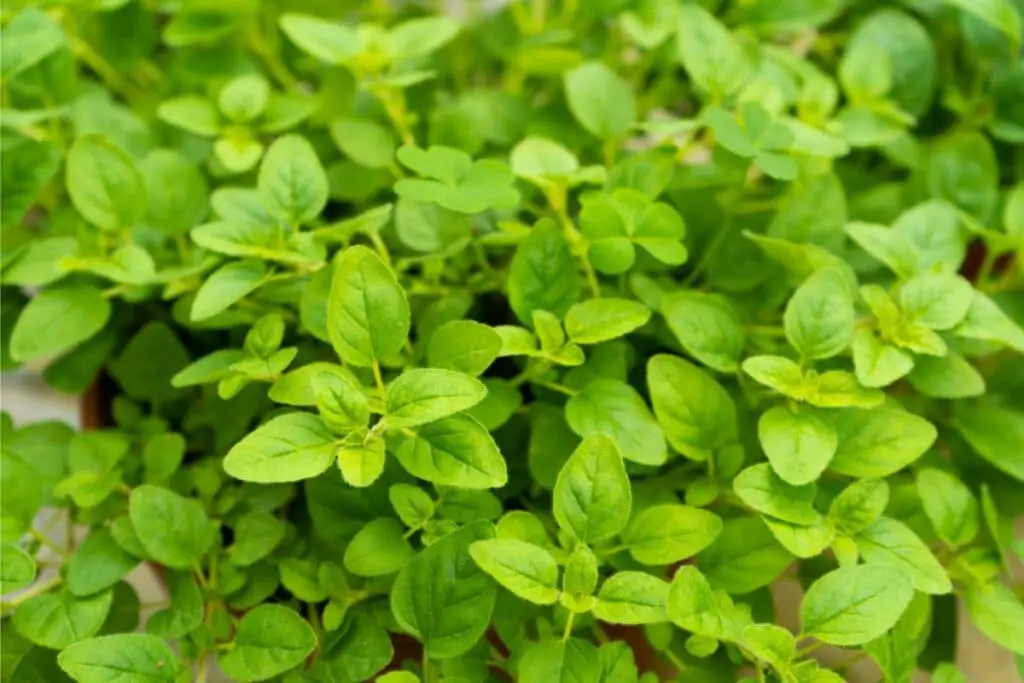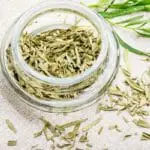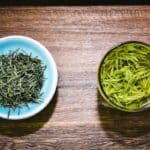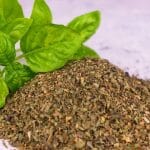In summary: Marjoram can be substituted with oregano, basil, thyme, sage, tarragon, etc. We also explain the difference between fresh and dried marjoram and offer quantity guidelines for each substitute.
With its warm, floral, woody flavor and slightly sweet and bitter notes, marjoram is a unique and flavorful herb used often in savory Mediterranean dishes.
Whether you’re making your own sausage or need it for a stew or stuffing recipe, don’t worry if you don’t have any on hand. Since it is part of the oregano and mint family, there are a few other herbs with similar undertones that can be used in a flash as a substitute for marjoram spice.
The replacement you choose will depend on the flavor profile of the dish you are making as well as whether your recipe calls for the fresh or dried herb. In this guide, we’ll help you pick the best marjoram substitute to ensure your dish is packed with flavor.
What Is Marjoram?
The herb has slightly fuzzy spade-shaped leaves with a broader base than the tip. It features an underlying sweetness balanced by bitter notes.
As a seasoning, it pairs well with other herbs such as basil, cumin, paprika, and rosemary. It is popularly used in meat mixtures such as German sausage, meatballs, and bolognese and goes well with cheese, egg, and tomato dishes.
The fresh leaves can be chopped and sprinkled over pizza and salad. When using the fresh herb in soups or stews, add it towards the end of the cooking time since exposure to heat will mute the flavor.
Dried herbs, on the other hand, can be added at the beginning of cooking to infuse and blend with other flavors. Marjoram is also used to make herb oil, flavored vinegar, or herbal tea.
Dried vs Fresh Marjoram
If your recipe calls for dry marjoram use a dried herb substitute as a replacement and uses fresh herbs to substitute fresh marjoram leaves in your recipe.
If your recipe calls for fresh herbs and you only have dry, you can use them but do not replace them in equal quantities since the dried form is generally more concentrated. As a general guideline, replace one tablespoon of fresh marjoram with a teaspoon of dried herbs.
Best Marjoram Substitutes
#1. Oregano
Dried oregano is pretty easy to find in most grocery stores and is likely something you already have in the pantry. Since fresh oregano is from the same herb family it has similar flavor notes, which makes it one of the best substitutes for marjoram in many dishes.
Oregano is popular for use in pizzas, so if you’re looking for a (dried or fresh) marjoram replacement when making pizza, this should be your go-to.
Quantity: Since oregano’s flavor is fairly strong, only use half the amount called for in marjoram recipes.
Best for: Sauces, salad dressings, meat, poultry, seasoning sausages, tomato-centric pasta dishes, stews, and vegetable dishes.
#2. Basil
Fresh basil is tender with large green leaves and features undertones of mint, anise, and pepper. Although this aromatic herb has a slightly different flavor, it will bring a beautiful herbaceousness to your dish, which makes it another good choice.
It is popularly used as the main ingredient in pesto and in a variety of Mediterranean recipes. Basil can be used either dried or fresh and should ideally be replaced in the same form that your recipe calls for.
Quantity: Replace fresh basil in equal amounts for fresh marjoram and dried basil in a 1:1 ratio for dried marjoram. When using the dried herbs as a placement for fresh herbs use only a third of the quantity required.
Best for: Vinaigrettes, salads (fresh leaves), pizza, poultry, pasta, and egg dishes.
#3. Thyme
Thyme is an evergreen herb with small green leaves. It has a pronounced herbal flavor with woody and floral undertones. Fresh thyme leaves can be used either whole or finely chopped.
The entire sprig can however also be added when roasting chicken, vegetables, meat, or making stews. When cooking with the whole sprig make sure to remove it before serving as the woody stems are not edible.
Quantity: Replace fresh for fresh and dried thyme for dry marjoram in equal quantities.
Best for: pork, poultry, lamb, beef, vegetables, lasagna, soup, and seafood
See more: What can I use instead of thyme?
#4. Lemon Thyme
Lemon thyme is very similar in taste and appearance to regular thyme, however, it has a more pronounced citrusy flavor. Use it in the same way as you would regular thyme.
#5. Sage
Sage has dark green oblong leaves with a slightly fuzzy texture. Sage doesn’t have the same pine and citrus notes but its peppery and earthy flavor also brings savouriness and depth which makes it a good alternative for marjoram.
Quantity: Replace sage in equal quantities. When using a dried substitute as a replacement for fresh herbs use only a third of the quantity required.
Best for: pork, duck, chicken, vegetables, fatty meats, pasta, stews, sauces, flavored butter, and omelets.
See more: Sage substitute
#6. Tarragon
This herb is recognized by its slender pointed leaves and pronounced licorice flavor. It also has subtle notes of mint, pepper, vanilla, and eucalyptus. Tarragon is best used in as a fresh substitute as the dried herbs lose some of the unique nuances.
Although the flavors are quite different, tarragon can bring deep herbaceous characteristics to your dish, the same way that marjoram does.
Substitute quantity: Substitute marjoram with fresh tarragon in equal quantities.
Best for: Chicken, fish, vegetables, eggs, and sauces.
Related: Tarragon alternative
#7. French Herbes de Provence
Herbes de Provence is an all-purpose dried seasoning with its origins in French cuisine and is also used in a lot of Mediterranean cooking.
The versatile herb blend generally has a base of fennel, marjoram, parsley, rosemary, tarragon, and thyme. Some recipes also add additional herbs such as basil, lavender, bay leaves, summer savory, chervil, or sage.
Since the blend already contains a small amount of marjoram, you will have similar flavor undertones in your dish. Keep in mind that if your recipe also calls for other herbs that are already in the blend, the herb mix will suffice as a good substitute for them too.
For example, if your recipe calls for marjoram and rosemary, leave out both herbs if you are using Herbes de Provence instead.
Quantity: Replace the dried herb blend in equal quantities for marjoram.
Best for: Soup, sauces, stew, lentil soup, fish and meat dishes, as well as salads.
#8. Za’atar
Za’atar is a Middle Eastern mixture of herbs and spices generally including marjoram, oregano, or thyme, and earthy spices like cumin, sumac, and coriander. It is mixed with toasted sesame seeds and salt.
It’s a great substitute since it already includes marjoram and will add flavor complexity to your dish.
Since it is a herb and spice blend, be careful about adding any other spices or herbs to the recipe when you are using Za’atar as a replacement.
Quantity: Use less of the spice and herb blend than the recipe calls for. Replace one tablespoon of fresh marjoram with one teaspoon of Za’atar.
Best for: Roasted and grilled vegetables, dry rub for meats, poultry seasoning, and potatoes.
Other herb mixes you can try as marjoram alternatives are Italian seasoning and poultry seasoning. Follow the same guideline as you would when using Za’atar.
FAQs
Is marjoram the same as oregano?
No, marjoram and oregano are not the same. Although they come from the same family of herbs and have similar flavor undertones, marjoram has an underlying sweetness, whereas oregano has a fragrant peppery flavor and slight bitterness.
Can I make marjoram tea from dried herbs?
Yes, you can make marjoram tea from dried herbs, if you don’t have fresh herbs to steep in hot water. Steep the dried leaves in boiling water for around three minutes before straining. Add honey if you prefer your drink on the sweeter side.
Is marjoram a spice or a herb?
Marjoram is a perennial herb that is part of the mint family.
What other spice does marjoram taste like?
Another spice marjoram taste like is oregano due to its close botanical relationship. But it’s generally milder and sweeter in flavor compared to the stronger, more robust taste of oregano.
Conclusion
Versatile and popular in savory applications, marjoram brings wonderful warm and woody notes with hints of pine and citrus to Mediterranean recipes. If it is not a herb you keep in your spice cabinet or panty, there are a few more common options you can use instead to bring loads of flavor to your dish.
Whether you use a single herb such as thyme or oregano, or a herb and spice blend such as Za’atar, make sure you taste while cooking to ensure you don’t overpower the other flavors in your dish with too many additions. Happy experimenting!
*image by Kukota/depositphotos









